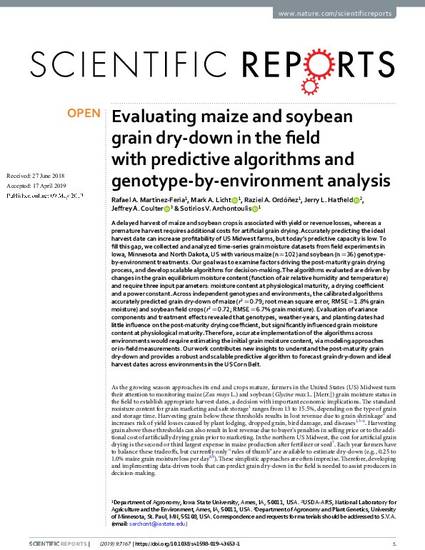
A delayed harvest of maize and soybean crops is associated with yield or revenue losses, whereas a premature harvest requires additional costs for artificial grain drying. Accurately predicting the ideal harvest date can increase profitability of US Midwest farms, but today’s predictive capacity is low. To fill this gap, we collected and analyzed time-series grain moisture datasets from field experiments in Iowa, Minnesota and North Dakota, US with various maize (n = 102) and soybean (n = 36) genotype-by-environment treatments. Our goal was to examine factors driving the post-maturity grain drying process, and develop scalable algorithms for decision-making. The algorithms evaluated are driven by changes in the grain equilibrium moisture content (function of air relative humidity and temperature) and require three input parameters: moisture content at physiological maturity, a drying coefficient and a power constant. Across independent genotypes and environments, the calibrated algorithms accurately predicted grain dry-down of maize (r2 = 0.79; root mean square error, RMSE = 1.8% grain moisture) and soybean field crops (r2 = 0.72; RMSE = 6.7% grain moisture). Evaluation of variance components and treatment effects revealed that genotypes, weather-years, and planting dates had little influence on the post-maturity drying coefficient, but significantly influenced grain moisture content at physiological maturity. Therefore, accurate implementation of the algorithms across environments would require estimating the initial grain moisture content, via modeling approaches or in-field measurements. Our work contributes new insights to understand the post-maturity grain dry-down and provides a robust and scalable predictive algorithm to forecast grain dry-down and ideal harvest dates across environments in the US Corn Belt.
Available at: http://works.bepress.com/mark-licht/198/

This article is published as Martinez-Feria, R.A., Licht, M.A., Ordóñez, R.A. et al. Evaluating maize and soybean grain dry-down in the field with predictive algorithms and genotype-by-environment analysis. Sci Rep 9, 7167 (2019). doi: 10.1038/s41598-019-43653-1.